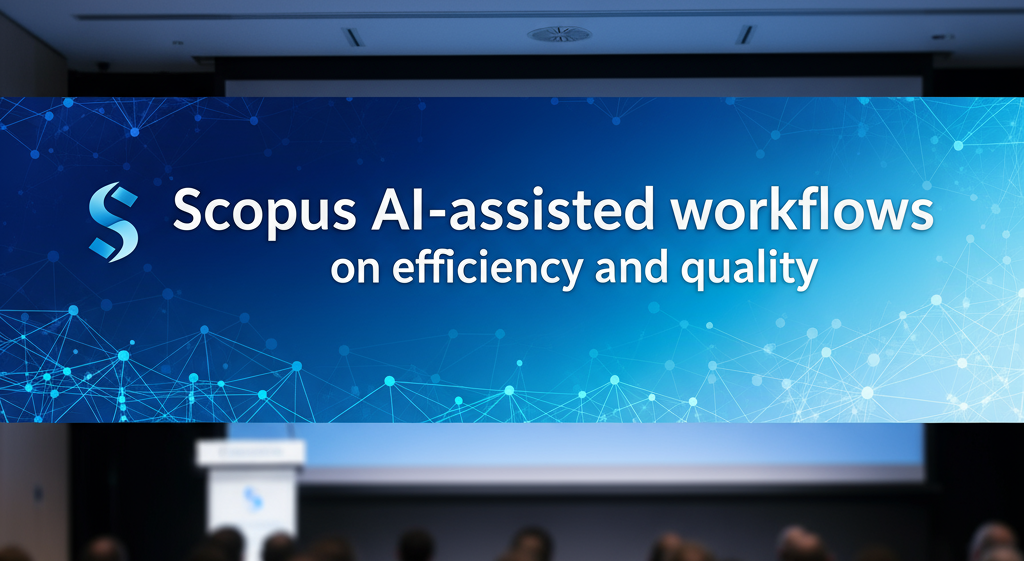How AI-Assisted Workflows in Scopus Transform Research Efficiency and Quality

In the rapidly evolving landscape of academic research, artificial intelligence is revolutionizing how scholars interact with scientific databases. Scopus, one of the world’s largest abstract and citation databases, has integrated AI-assisted workflows that promise to transform research efficiency and quality. This comprehensive analysis explores how these technological advancements are reshaping the research process, while addressing both opportunities and challenges.
The Evolution of AI Integration in Scopus
The integration of AI into Scopus represents a paradigm shift in academic database functionality. According to recent research by Nogueira (2025), Scopus AI combines the communication properties of large language models with the information integrity of peer-reviewed sources, creating a unique ecosystem that maintains scientific rigor while enhancing accessibility[1].
🔍 Natural Language Processing Revolution
One of the most significant advances is the elimination of Boolean operators. Researchers can now engage with the database using natural language queries, making sophisticated searches accessible to users regardless of their technical expertise. This democratization of database access has profound implications for interdisciplinary research and global academic collaboration.
Key Features Driving Efficiency Improvements
1. Automated Task Management
AI implementation in research workflows has demonstrated remarkable efficiency gains. According to Wenderott et al. (2024), 67% of studies report significant time reductions in medical imaging tasks when AI assistance is employed[2]. This efficiency extends beyond medical fields, with similar improvements observed across various academic disciplines.
2. Intelligent Bibliometric Analysis
AI tools within Scopus enable sophisticated bibliometric analysis that would traditionally require extensive manual effort. Researchers can now:
- Identify emerging trends and patterns in their field
- Discover related keyword phrases and conceptual connections
- Map the evolution of research topics over time
- Analyze citation networks with unprecedented depth

3. Enhanced Editorial Workflows
As highlighted by Biondi-Zoccai et al. (2025), AI tools are revolutionizing editorial processes through automated plagiarism detection and data verification, leading to substantial time savings and cost reductions[3]. These improvements ensure higher quality publications while reducing the burden on editorial teams.
Impact on Research Quality and Productivity
Human-Machine Collaboration
Tomczyk et al. (2024) emphasize that AI’s contribution to systematic literature reviews (SLRs) represents a fundamental shift in research methodology[8]. The synergy between human expertise and AI capabilities creates a powerful combination where:
“AI enhances efficiency and quality while human oversight ensures critical thinking, contextual understanding, and ethical considerations remain at the forefront of research activities.”
This collaborative approach addresses concerns about AI replacing human researchers, instead positioning AI as a sophisticated tool that amplifies human capabilities.
Addressing Limitations and Ethical Considerations
User Competency Requirements
Despite the intuitive nature of AI-assisted workflows, researchers must develop new competencies. Understanding how AI processes information, recognizing potential biases, and maintaining scientific skepticism are crucial skills in the AI-enhanced research environment.
Ethical and Regulatory Challenges
Medical journal editors have expressed legitimate concerns about AI integration, including:
- Bias amplification: AI systems may perpetuate existing biases in academic literature
- Accountability issues: Questions arise about responsibility when AI makes errors
- Transparency concerns: The “black box” nature of some AI algorithms challenges traditional peer review processes
Evwiekpaefe and Tohomdet (2024) call for robust AI systems that prioritize fairness and transparency, emphasizing the need for interdisciplinary approaches to address these challenges[10].
Future Directions and Best Practices
Embracing Service Modernization
Kulkanjanapiban et al. (2025) highlight how AI-driven innovations are modernizing academic libraries and research support services[4]. Institutions that successfully integrate AI-assisted workflows report:
Implementation Recommendations
- Invest in Training: Develop comprehensive training programs for researchers to maximize AI tool utilization
- Maintain Critical Oversight: Establish protocols for human verification of AI-generated insights
- Foster Interdisciplinary Collaboration: Encourage cross-departmental projects that leverage AI capabilities
- Prioritize Ethical Guidelines: Develop clear policies for AI use in research activities
Transform Your Research Workflow Today
Discover how AI-assisted workflows can revolutionize your research productivity and quality. Learn more about implementing these technologies in your academic institution.
Explore AI in AcademiaConclusion: Balancing Innovation with Integrity
AI-assisted workflows in Scopus represent a significant advancement in research methodology, offering unprecedented efficiency gains and quality improvements. The 67% time reduction in various research tasks demonstrates the tangible benefits of AI integration. However, success requires careful balance between embracing technological innovation and maintaining the ethical and methodological rigor that defines quality research.
As we move forward, the key to maximizing the benefits of AI-assisted workflows lies in thoughtful implementation, continuous evaluation, and commitment to maintaining the human elements that ensure research remains relevant, ethical, and impactful. The future of academic research is not about replacing human intelligence with artificial intelligence, but rather about creating synergies that elevate the entire research enterprise.
